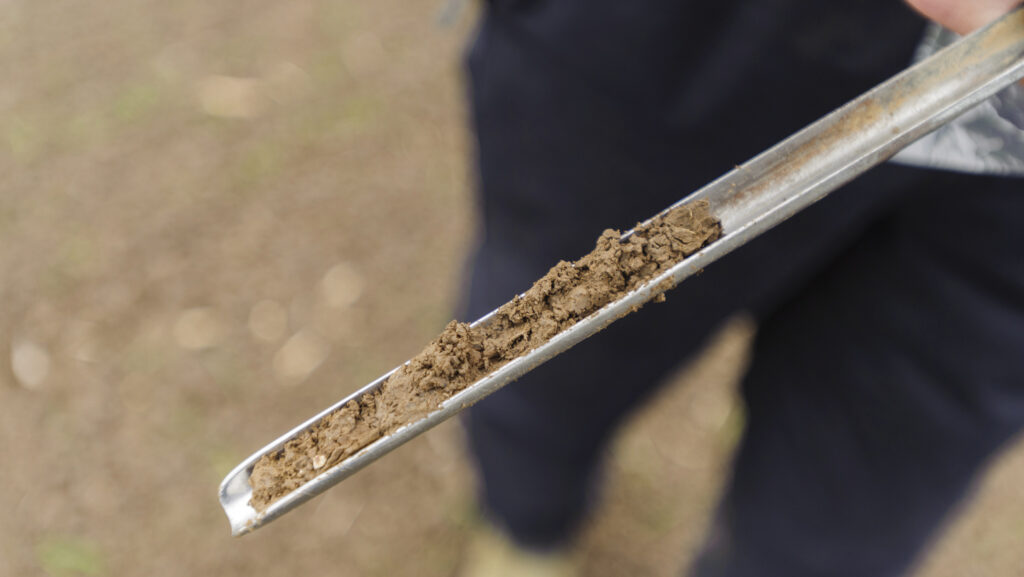Groundswell: How John Kempf prevents yield declines in regen ag
 © Groundswell
© Groundswell If done correctly, transitioning to regenerative agriculture should come with yield increases not declines, according to US regen guru John Kempf.
Speaking to a packed Big Top audience at Groundswell in a session entitled ‘Untapped potential in regenerative ag’ he claimed plants had the capacity to be completely resistant to all diseases and all insects as long as their immune systems were supported with nutrition and a foundational microbiome.
“It is possible to grow plants in such a way that they’re completely resistant to diseases and insects,” he said. “And it’s not that difficult, just different.”
See also: 9 steps to obtain accurate combine yield data this harvest
The agronomy firm he founded, Advancing Eco Ag, supplies nutritional products to farmers as well as providing advice across 1.6m ha in North America.
It takes a systemic approach to evaluate soil health, soil microbial function and plant nutritional balance.
The firm’s agronomic aim was to grow healthy plants that produced the highest yields possible with a functional immune system and were resistant to diseases and insects, he said.
“When you produce plants that have such robust immune function that they are resistant to diseases and pests, not only does that eliminate the need for pesticides, but also when you have abundantly healthy plants, you can’t stop yields from increasing.”
This blew a hole in the argument often heard that growers should expect to see yield declines while transitioning to regenerative agriculture, he said.
Yield up not down
“Our experience is that when you manage agronomy and plant nutrition well, you should expect to see yields go up.
“How can you have abundantly healthy plants and expect to see yields decline?” he asked.
“So our approach has been to focus obsessively on delivering immediate economic results in the first year.”
This was an important distinction, he said, because most farmers didn’t have a three-to-five-year financial window where they could handle lower returns while yields declined and/or they were investing in cover crops, integrating livestock or different cultural management practices.
“As a result, we started thinking about how to manage agronomy and plant nutrition to produce an immediate crop response in the first year.”
The foundations for the “remarkable” crop results AEA achieves were managing nutrition and the soil microbiome, he said.
“It’s not eliminating pesticides and planting cover crops – those happen after.
“You have to earn the right to reduce pesticide applications if you want to do so in a manner that produces immediate economic results.”

© Jason Bye
Five-step process
Achieving success was a five-step process, he said. “The first step is increasing photosynthesis. We have plants, as a result of mineral nutrition and microbiome depletion, that no longer photosynthesise efficiently.”
Typically crop plants only reached 15-20% of their inherent photosynthetic efficiency, but increasing that to 45-60% tripled the number of sugars that were produced, he said.
“Those sugars are sent out through the root system as exudates and feed soil biology – that’s step two.
“That translates to accelerated microbial activity, an increased microbial population in the rhizosphere and the soil environment, and then minerals being made available to plants more efficiently.
“And that leads to step five, increased disease and pest resistance and exceptional harvest quality.
“We have observed this with many growers, who we work with intensely on their nutrition and agronomic management.
“Then as we get the ecosystem pieces right and we have the right companion plants, cover crops and appropriate nutrition management, it becomes a self-perpetuating system that doesn’t require constant spoon-feeding and support,” he claimed.
Putting this into action practically starts with a thorough evaluation of the farm including multiple soil analyses, such as analysis of total nutrients and cation exchange capacity (CEC).
These quantify nutrient availability and the levels that can be delivered by the soil.
“We also need to understand the parent geological bedrock and what nutrients that can deliver.
“If you have a soil geological profile that contains no selenium, or molybdenum, or cobalt, for example, it doesn’t matter how abundant the microbial profile, they will never deliver those nutrients until you address them.”
Knowing which specific diseases, insects and weeds are problematic on the farm is also important.
“They tell us a story. Over the past 15 years we have been able to correlate specific diseases or pests with particular nutritional profiles.

© Tim Scrivener
Flea beetle in OSR
“For example, if you have flea beetles on oilseed rape, you will have deficiencies of some combination of magnesium, sulphur, molybdenum or boron.
“The plants won’t be metabolising nitrogen and proteins properly as a result of an imbalance of those elements and when you address them, flea beetles will cease to be a problem,” he declared.
Both seed treatments – mineral and microbial – and foliar applications, the latter assessed using regular in-season plant sap analysis are used to manage plant nutritional needs.
“What we have observed with growers beginning a transition is that the applications that provide the greatest economic crop response and are easiest to apply are seed treatments, while the application that can build soil health faster than any other are foliar nutritional applications,” he said.
Seeds should be thought of as microbial inoculants, he continued. “A corn seed contains 9bn microorganisms inside of it.”
These microorganisms, known as endophytes, help plants get nutrients through something called the rhizophagy cycle (see box).
“We’re still trying to determine what proportion of a crops nutritional requirements can be supplied via the rhizophagy cycle, but for most cultivated crops I think it could be 100%.
“But if you want to shut it down, applying fungicides, nitrogen and phosphorus fertiliser are three very effective tools.”
The primary purpose of foliar nutritional applications should be to increase the plant’s photosynthetic rate, John stressed.
That was different to most people’s assumption that the primary aim was addressing nutrient deficiencies.
“A well-designed foliar application can create a temporary photosynthetic spike, which in most agricultural systems lasts for around two to three weeks,” he said.
“This results in more sugars being added to the soil to build soil biology and soil carbon.
“The single fastest and most economical way I know of rapidly regenerating soil health is to harness the plant’s photosynthetic engine,” he concluded.
What is the rhizophagy cycle?
The rhizophagy cycle is a process in which plants absorb bacteria from the soil through their roots, use the nutrients inside the bacteria for their own growth and development, and then release the bacteria back into the soil through root hairs.
This cycle allows plants to communicate their nutritional needs to the bacteria, which in turn extract minerals from the soil and deliver them back to the plants.
It is a symbiotic relationship between plants and bacteria that helps plants obtain the necessary nutrients for their survival.
Who is John Kempf?
John Kempf grew up on a small family fruit and vegetable farm in northeast Ohio, covering 10ha, primarily growing fresh market vegetable crops such as tomatoes, courgettes, cucumbers, and cantaloupe.
His father was the local supplier of seeds, fertilisers, and pesticides.
John’s interest in regenerative agriculture and plant health began in the early 2000s when his family experienced significant crop losses due to diseases and insects that were not effectively managed with pesticide applications.
This led him to explore the role of nutrition and microbiome health in supporting plant immune systems, and eventually founding Advancing Eco Ag in 2006.
AEA works directly with growers to help them become more resilient, efficient and profitable, partly through the use of a unique line of crop nutrition products and biological inoculants.
John hosts the Regenerative Agriculture podcast, and produces webinars and other educational material.

